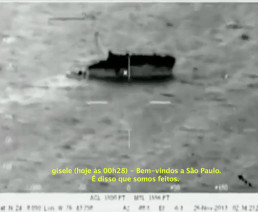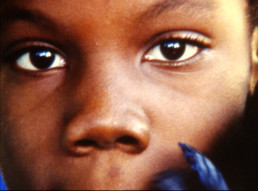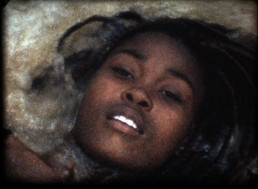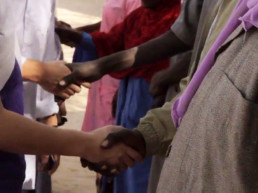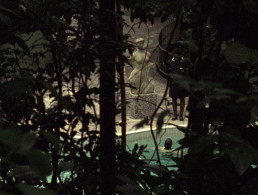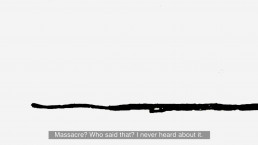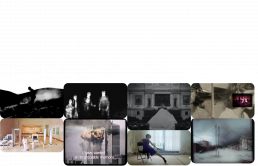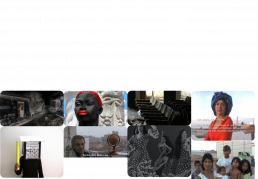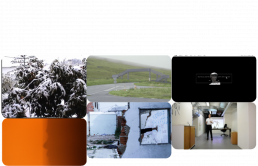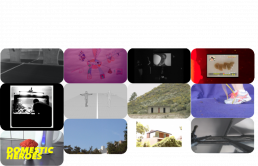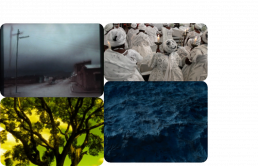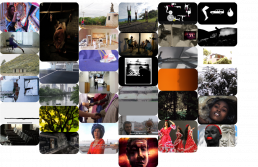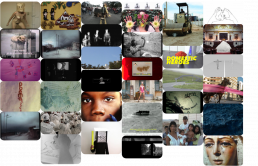“FUSO 2017 – 22 a 27 de Agosto“
25 Agosto, 22h
Museu Nacional de Arte Antiga (MNAA)
Os Afogados, os Sobreviventes e o Arquiteto
Curadoria de Lisette Lagnado
Duração da sessão 65’
Os filmes que compõem esta seleção apresentam, com diferentes tonalidades, o viés autoritário que perdura no tecido social de países que, há décadas, declararam a sua independência nacional. Mais ambíguas ou pérfidas, as formas contemporâneas de violência pós-colonial não deixam de perpetuar preconceitos étnicos e atos contra a dignidade da vida.
Há setenta anos, o químico italiano Primo Levi lançava o livro Se isto é isto um homem, narrando níveis de degradação em campos de concentração durante a Segunda Guerra Mundial. O relato deveria constituir uma advertência no contexto atual em que o número de refugiados no mundo superou os 60 milhões. Ora, não é difícil imaginar o que teria acontecido nos anos 1930 e 1940 se os mecanismos de controlo migratório negassem asilo aos sobreviventes.
A programação estrutura-se em duas partes. Na primeira, Regina Parra e Louise Botkay abordam o caos humanitário do Haiti e do Chade. Na segunda parte, as artistas Tamar Guimarães e Clara Ianni debruçam-se sobre as contradições do projeto de um Brasil moderno. Tomando Oscar Niemeyer como figura emblemática, cada uma à sua maneira revela traços da elite autocrática na formação da sociedade brasileira. No filme Canoas, residência do arquiteto situada na Floresta da Tijuca, no Rio de Janeiro, Guimarães orquestra uma estranha aliança entre o uso mundano do local e a utopia construtiva que marcou a vanguarda. Já Forma livre de Ianni abre uma fissura inquietante sobre o custo humano de uma política de Estado que fez de Brasília, além de nova capital, um mito fundador.
Com pungência e delicadeza, esses filmes traduzem o curso inexorável da violência – até mesmo quando a câmara acompanha crianças reproduzindo uma liturgia transmitida pela hegemonia branca.
Lisette Lagnado, 2017, a partir do título Os afogados e os sobreviventes, último livro de Primo Levi publicado em vida (1986)
Regina Parram, Sobre la marcha II – O sobrevivente, 2015, 8’23’’
Comentários escritos por cibernautas, diante de uma notícia do portal UOL que noticia a recém-chegada de um grande grupo de haitianos no Brasil, mostram que a imagem de hospitalidade do país não corresponde à realidade. A migração haitiana intensificou-se após o terramoto de 2010, e a imprensa tem relatado casos de abusos e preconceitos.
Desenho de som Raphael Lupo
Louise Botkay, Vertières I, II, III, 2014, Haiti, 9’36’’, película super 8 transferida para digital, cor
A ternura das imagens iniciais apresenta jovens raparigas de uma turma escolar a rezarem em coro versos que agradecem o Senhor por “todas as maravilhas realizadas”. Vertières deu nome à batalha que aconteceu no dia 18 de novembro de 1803 na ex-colónia francesa Saint-Domingue, hoje Haiti, e resultou na independência da primeira nação livre da América Latina e do Caribe. O filme foi indicado pela revista Artforum como um dos dez melhores de 2015.
Louise Botkay, Sugar Freeze, 2011, Congo, 10’, película super 8 transferida para digital, cor
Às margens do rio Congo, a câmara capta pequenas cenas quotidianas que misturam brincadeiras entre crianças e jovens. Como os demais filmes da autora, não há um script pré-determinado.
Louise Botkay, Mains Propres, 2011, 10’
Imagens cruas destacam a hipocrisia dos processos pós-coloniais, marcados por longas guerras civis que vêm dizimando as populações locais. Ironicamente, os atendimentos de saúde e comida dependem da ajuda humanitária dos países “brancos”. O filme recebeu o prémio e-flux do Festival de Oberhausen em 2016.
Tamar Guimarães, Canoas, 2010, 13’30’’
Construída em 1954, a “Casa das Canoas” é a terceira residência do arquiteto brasileiro Oscar Niemeyer. A câmara capta conversas soltas ao longo de uma pequena festa noturna, regada com taças de champagne, em que personagens do circuito artístico circulam pela exuberância tropical do cenário, contando curiosidades sobre o modernismo brasileiro.
Clara Ianni, Forma livre, 2013, 7’14’’
Durante a construção de Brasília, em 1959, uma greve acontece no alojamento dos operários. Lucio Costa e Oscar Niemeyer refutam as perguntas do entrevistador sobre a chacina de cem operários, diminuindo a amplidão do episódio frente à importância da futura capital do Brasil.
Edição Clara Ianni e Nina Senra
Gráficos Lucio Costa
Fotografias Marcel Gauherot
Entrevistas Vladimir Carvalho com Lucio Costa e Oscar Niemeyer
Desenho de som Caio Gonçalves
“FUSO 2017 – August 22 to 27“
August 25, 22h
Museu Nacional de Arte Antiga (MNAA)
The Drowned, The Survivors and The Architect
Curatorship by Lisette Lagnado
Total running time 56’
The films that make up this selection present, with different levels, the authoritarian bias that lingers in the social fabric of countries that, for decades, have declared their national independence. More ambiguous or perfidious, contemporary forms of postcolonial violence do not fail to perpetuate ethnic prejudices and acts against the dignity of life.
Seventy years ago, the Italian chemist Primo Levi released the book If This Is a Man chronicling levels of degradation in concentration camps during World War II. His account should be a warning in the current context where the number of refugees in the world has exceeded 60 million. It is not difficult to imagine what would have happened in the 1930s and 1940s if the mechanisms of migration control denied asylum to the survivors.
This program is structured in two parts. In the first, Regina Parra and Louise Botkay address the humanitarian chaos of Haiti and Chad. In the second part, the artists Tamar Guimarães and Clara Ianni focus on the contradictions of the project of a modern Brazil. Taking Oscar Niemeyer as an emblematic figure, each in its own way reveals traces of the autocratic elite in the formation of Brazilian society. In the film Canoas, the architect’s residence by the Tijuca Forest, Rio de Janeiro, Guimarães orchestrates a strange alliance between the worldly use of the place and the constructive utopia that marked the vanguard. Forma Livre (Free Form), by Ianni, opens a disturbing fissure related to the human cost of a State policy that made Brasilia, beyond a new capital, a founding myth.
With pungency and delicacy, these films translate the inexorable course of violence – even when the camera accompanies children reproducing a liturgy transmitted by white hegemony.
Lisette Lagnado, 2017, from Primo Levi’s last book The Drowned and the Saved (1986)
Regina Parram, Sobre la marcha II – O sobrevivente, 2015, 8’23’’
Comments written by Internet users, following a news item on UOL’s website reporting the recent arrival of a large group of Haitians to Brazil, show that the hospitality scenery of the country does not match the reality. Haitian migration intensified after the earthquake of 2010, and the press has reported cases of abuse and prejudice.
Sound design Raphael Lupo
Louise Botkay, Vertières I, II, III, 2014, Haiti, 9’36’’, super 8 film transferred into digital, colour
The tenderness of the opening images presents young girls of a school class praying, in a chorus, to thank the Lord for “all the wonders performed”. The Battle of Vertières took place on November 18th, 1803 in the former French colony Saint-Domingue, now Haïti, and resulted in the independence of the first free nation of Latin America and the Caribbean. The film was selected by Artforum magazine as one of the top ten in 2015.
Louise Botkay, Sugar Freeze, 2011, Congo, 10’, super 8 film transferred into digital, colour
The camera picks up small everyday scenes of children and adolescents playing on the banks of the Congo River. Like the author’s other films, there is no use of a pre-determined script.
Louise Botkay, Mains Propres, 2011, 10’
Raw images highlight the hypocrisy of post-colonial processes, marked by long civil wars that have been decimating the locals. Ironically, health care and food supply depend on humanitarian aid from “white” countries. The film received the e-flux award of the Oberhausen Festival in 2016.
Tamar Guimarães, Canoas, 2010, 13’30’’
Built in 1954, “Casa das Canoas” is the third residence of Brazilian architect Oscar Niemeyer. The camera picks up loose conversations during a small nocturnal party, washed down with champagne. Characters from the art world move by the tropical exuberance of the scene, talking about the curiosities of Brazilian modernism.
Clara Ianni, Forma livre (Free form), 2013, 7’14’’
During the construction of Brasilia in 1959, a strike takes place in the workers’ quarters. Lucio Costa and Oscar Niemeyer refute the interviewer’s questions about the slaughter of 100 workers, minimizing the extent of the episode in view of the importance of Brazil’s future capital.
Editing Clara Ianni and Nina Senra
Graphics Lucio Costa
Photos Marcel Gauherot
Interviews Vladimir Carvalho with Lucio Costa and Oscar Niemeyer
Sound design Caio Gonçalves
